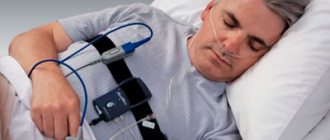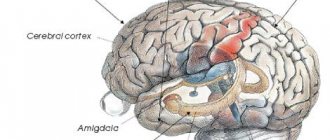Epilepsy is one of the most common diseases of the nervous system. Therefore, when faced with an illness, patients ask themselves the question: is it possible to be cured of epilepsy forever? Unfortunately, this disease is incurable. But up to 65% of patients can live virtually free of seizures and other clinical symptoms, provided they undergo appropriate medical examination and receive proper treatment. Often it is not the disease itself that causes death, but incorrect or untimely assistance.
Epilepsy is not a death sentence. Thanks to the rapid development of medicine, patients suffering from epilepsy have a chance to lead a normal, fulfilling life.
Epilepsy is a purely neurological disease. Outside of seizures, a person with epilepsy is no different from others. However, it is worth recognizing an unpleasant fact - such people are treated with caution in society. The fact is that the term “epilepsy” has become overgrown with myths and stereotypes that may not correspond to reality.
It is necessary to attract the attention of not only patients, but also healthy people to the problem of epilepsy.
Since 2008, on March 26, the so-called purple day is celebrated all over the world - Day against Epilepsy. This is a chance for everyone to learn about the disease, its causes and treatment.
general information
Epilepsy attacks have been known to people for a very long time. It was either mistaken for demonic possession or associated with a person’s special talent. Today, one or another form of pathology is observed in 10 people out of 1000. Symptoms can occur in newborns and the elderly, in men and women with the same frequency. Moreover, similar processes occur in the central nervous system of some animals, for example, dogs.
The main mechanism for the occurrence of attacks is the synchronization of the work of all nerve cells in a certain area. It is called an epileptogenic focus and determines the set of symptoms and their severity. Contrary to popular belief, the disease is not limited to seizures with loss of consciousness. There are a large number of variants of seizures with varied symptoms, depending on the area of the brain in which the pathological focus occurs.
Make an appointment
When to see a doctor
To prevent further development of the disease, it is necessary to consult a doctor immediately after the first attack or the appearance of indirect symptoms of epilepsy. The sooner the diagnosis is made and treatment is started, the more favorable the prognosis for recovery will be.
With such a disease, you need to contact a pediatric neurologist. At JSC “Medicine” (clinic of Academician Roitberg), located in the center of Moscow, experienced specialists conduct appointments. The clinic is equipped with all the necessary equipment for correct and accurate diagnosis of diseases. A detailed account of how the attacks progress will be a huge help in making a diagnosis. Even more helpful is a video that one of the parents can take during the seizure.
Causes
The functioning of the brain is a complex process that requires the constant interaction of many structures. A failure at any level can cause the formation of an epileptogenic focus. Among the most common causes of epilepsy in adults and children are:
- heredity;
- traumatic brain injuries;
- acute or chronic intoxication, especially alcoholism;
- infectious lesions of the brain or its membranes (encephalitis, meningitis);
- acute and chronic cerebrovascular accidents, including strokes;
- malignant and benign tumors in the cranial cavity;
- birth injuries;
- parasites that develop in brain structures: echinococcus, pork tapeworm;
- neurodegenerative diseases (Alzheimer's disease, multiple sclerosis, Pick's disease);
- hormonal imbalances, especially lack of testosterone;
- metabolic disorders, etc.
There are cases when the cause of epilepsy cannot be identified. In this case, the disease is called idiopathic.
Various generalized types of epileptic seizures include:
Generalized tonic-clonic seizures. Most often they appear when the discharge spreads throughout the cerebral cortex and can be manifested by the patient’s shrill cry + unnatural tongue bite, tension and twitching of the whole body, increased heart rate, increased blood pressure.
Absence seizures. They may first appear at a young age or early adolescence. Usually, at the time of an epileptic attack, the child’s gaze suddenly freezes and is fixed on one point, while his eyelids may twitch. Then, swallowing movements, throwing the head back may be more often observed, or, conversely, the patient drops his head; rarely there may be manifestations of a vegetative nature. The duration of these attacks is no more than 30-45 seconds.
Myoclonic seizures. They arise quite suddenly for the person himself, but have a very long duration. This attack externally manifests itself in involuntary muscle contraction, which often affects not only the head, arms and legs, but also the entire body.
Tonic seizures. They manifest themselves in the form of sharp, varying duration of tension in various muscle groups, mainly on both sides, and can be accompanied by a fall, including a sharp fall forward with injury.
Atonic (attacks of falls). Perhaps, they are still considered the rarest types of this disease and, accounting for only 1.5% of the total number of epileptic seizures, are diagnosed in the most complex forms of epilepsy.
Types and symptoms
Epilepsy is multifaceted and multifaceted; its symptoms are not limited to seizures. The most common classification is depending on the severity of attacks and their main manifestations.
Aura (harbingers)
Many epileptic seizures begin with an aura. This is the name given to a complex of specific sensations that occurs shortly before a seizure. Manifestations of an aura can be completely different: paresthesia (pathological sensations), a specific taste in the mouth, auditory, visual or olfactory hallucinations, etc. Before the appearance of an aura, a person often begins to experience causeless anxiety and internal tension.
Partial (focal) seizures
These conditions occur when a small area of the brain is involved in pathological overexcitation.
Simple partial seizures are characterized by preserved consciousness and last only 1-2 minutes. Depending on the location of the pathological focus, a person feels:
- sudden change of mood for no apparent reason;
- small twitching in a certain part of the body;
- feeling of déjà vu;
- hallucinations: lights before the eyes, strange sounds, etc.;
- paresthesia: a feeling of tingling or crawling in any part of the body;
- difficulty pronouncing or understanding words;
- nausea;
- change in heart rate, etc.
Complex attacks are characterized by more severe symptoms and often affect consciousness and thinking. Human can:
- lose consciousness for 1-2 minutes;
- there is no point in looking into emptiness;
- scream, cry, laugh for no apparent reason;
- constantly repeat any words or actions (chewing, walking in a circle, etc.).
Typically, during a complex seizure and for some time after it, the patient remains disoriented for some time.
Generalized seizures
Generalized seizures are one of the classic signs of epilepsy that almost everyone has heard of. They occur if the epileptogenic focus has spread to the entire brain. There are several forms of seizures.
- Tonic convulsions. The muscles of most of the body (especially the back and limbs) simultaneously contract (come to tone), remain in this state for 10-20 seconds and then relax. Such attacks often occur during sleep and are not accompanied by loss of consciousness.
- Clonic convulsions. Rarely occur in isolation from other types of attacks. Manifested by rhythmic rapid contraction and relaxation of muscles. The movement cannot be stopped or delayed.
- Tonic-clonic seizures. This type of attack is called grand mal, which means “great illness” in French. The attack is divided into several phases: precursors (aura);
- tonic convulsions (20-60 seconds): the muscles become very tense, the person screams and falls; at this time his breathing stops, his face becomes bluish, and his body arches;
- clonic convulsions (2-5 minutes): the muscles of the body begin to contract rhythmically, the person thrashes on the floor, foam is released from the mouth, often mixed with blood due to a bitten tongue;
- relaxation: convulsions stop, muscles relax, involuntary urination or defecation often occurs; consciousness is absent for 15-30 minutes.
After the end of a generalized seizure, a person remains for 1-2 days feeling overwhelmed, problems with coordination of movements and fine motor skills. They are associated with cerebral hypoxia.
- Atonic attacks. They are characterized by short-term muscle relaxation, accompanied by loss of consciousness and falling. The attack lasts literally 10-15 seconds, but after it ends the patient does not remember anything.
- Myoclonic seizures. They manifest themselves as rapid twitching of the muscles of individual parts of the body, usually the arms or legs. The seizure is not accompanied by loss of consciousness.
- Absence seizures. The second name for attacks is petit mal (minor illness). This symptom of epilepsy occurs more often in children than in adults and is characterized by a short-term loss of consciousness. The patient freezes in place, looks into emptiness, does not perceive speech addressed to him and does not react to it. The condition is often accompanied by involuntary blinking of the eyes, small movements of the hands or jaws. The duration of the attack is 10-20 seconds.
Pediatric epilepsy
Childhood epilepsy has many masks. In newborns, it can be manifested by periodic muscle contractions that do not resemble seizures, frequent tilting of the head back, poor sleep and general restlessness. Older children may suffer from classic seizures and absence seizures. Partial seizures most often occur:
- severe headaches, nausea, vomiting;
- short periods of speech disorder (the child cannot utter a single word);
- nightmares followed by screams and hysterics;
- sleepwalking, etc.
These symptoms are not always a sign of epilepsy, but they should serve as a reason for an urgent visit to the doctor and a full examination.
Precursors of epileptic seizures
The first harbinger of epileptic seizures is an aura. It is individual for each patient. Thanks to the constant warning signs, patients can warn others about the onset of an attack or independently move to a safe place.
There are the following types of aura that precede the onset of an epileptic attack:
- Hallucinations;
- Sharp contraction of the muscles of the upper or lower extremities;
- Repeating the same movements;
- Burning, crawling or tingling sensation in various parts of the body;
- Sharp deterioration in mood.
The duration of the aura is several seconds. During this time, patients do not lose consciousness.
Diagnostics
Neurologists diagnose and treat epilepsy. Some of them specifically expand their qualifications in this area, which allows them to act even more effectively.
Examination of a patient with suspected epilepsy includes the following methods:
- collection of complaints and medical history: the doctor asks the patient in detail about the symptoms that bother him, finds out the time and circumstances of their occurrence; a characteristic sign of epilepsy is the appearance of seizures against the background of sharp sounds, bright or flashing lights, etc.; special attention is paid to heredity, past injuries and diseases, the patient’s lifestyle and bad habits;
- neurological examination: the doctor evaluates muscle strength, skin sensitivity, severity and symmetrical reflexes;
- EEG (electroencephalography): a procedure for recording the electrical activity of the brain, allowing one to see the characteristic activity of an epileptogenic focus; if necessary, the doctor may try to provoke overexcitation using flashes of light or rhythmic sounds;
- MRI of the brain: makes it possible to identify pathological areas and formations: tumors, fissures, ischemic areas, consequences of a stroke, etc.;
- angiography of the vessels of the head: injection of a contrast agent into the blood followed by radiography; allows you to see areas of vasoconstriction and deterioration of blood flow;
- Ultrasound of the brain (Echo-encephalogram): used in children of the first year of life whose fontanel has not yet closed; visualizes tumors and other space-occupying formations, fluid accumulation, etc.;
- rheoencephalography: measurement of electrical resistance of head tissue, which can be used to diagnose blood flow disorders;
- general examinations: general blood and urine tests, blood biochemistry, tests for infections, ECG, etc. for a comprehensive assessment of the patient’s condition;
- consultations with specialized specialists: neurosurgeon, toxicologist, narcologist, psychiatrist, etc. (prescribed depending on the suspected cause of the attacks).
The list of studies may vary depending on the patient’s age, type of attack, presence of chronic pathologies and other factors.
What it is?
Many people have heard about epilepsy and mistakenly attribute it to mental illness. But that's not true. Epilepsy affects the nervous system and is characterized by the presence of lesions. This neurological disease is accompanied by seizures. The patient cannot predict the onset of an attack. Epilepsy is truly dangerous because of its unpredictability. Diagnosis and treatment of the disease includes a number of studies and methods that contribute to an accurate diagnosis. There is no need to panic if you have had a single attack. This does not yet indicate the presence of a diagnosis. When seizures recur and are severe, then there is reason to begin treatment for epilepsy.
The disease often develops in childhood, but it is not included in the list of purely childhood diseases. There are cases where patients learned their diagnosis in adulthood. Epilepsy is inherited in 10% of cases. In adults, the disease develops against the background of other diseases. For example, with brain tumors. Alcohol intoxication is a common cause of this disease. Alcoholic epilepsy is included in a group of pathological conditions characterized by the development of convulsive or non-convulsive seizures associated with alcohol consumption.
The most common forms of epilepsy are:
- Febrile seizures are only partially associated with epilepsy because patients do not require daily antiepileptic drug therapy. Mostly, seizures occur in children aged 3 months to 6 years.
- Benign rolandic epilepsy is characterized by infrequent, mild seizures that occur primarily during nighttime sleep. But sometimes patients need to take antiepileptic drugs.
- Juvenile myoclonic epilepsy is highly treatable. Stable remission is observed in 75–85% of patients. The attacks are mild and occur mainly after waking up.
- Infantile spasms is an epileptic syndrome observed in children aged 3-7 months. It stops when the child is 2-4 years old, but there is a danger that infantile spasms will develop into another form. 1/5 of cases of infantile spasms subsequently develop into Lennox-Gastaut syndrome. A child's seizures may last only a few seconds, but may occur repeatedly throughout the day. Children suffering from this form of epilepsy experience psychomotor impairment or delayed intellectual development.
- Lennox-Gastaut syndrome is quite rare. It is characterized by a combination of attacks of several types and their resistance to drug therapy. This form is difficult to treat, but sometimes it is possible to achieve partial control over the seizures.
- A form of reflex epilepsy usually develops during adolescence. The disease is diagnosed more often in girls than in boys. The causes of attacks are external irritating factors. In approximately 50% of patients, seizures occur only in response to rhythmic light stimulation, and in other cases they are triggered by flashing lights. Sometimes attacks appear spontaneously.
- Temporal lobe epilepsy is one of the most common types of epilepsy, which is characterized by the location of the epileptic focus in the temporal region of the brain. This form is the most difficult to treat; in 30% of cases, drugs have no effect at all. The onset of a seizure in temporal lobe epilepsy is usually expressed by involuntary movements. In rare cases, the patient freezes in an unnatural position during an attack.
- Frontal epilepsy (frontal epilepsy) is a severe form of the disease. The attacks begin suddenly and end quickly. Due to the nature of the disease, it is difficult to diagnose.
Each form of epilepsy has its own differences in manifestations. But is it possible to cure epilepsy if you consult a specialist in time? This is possible if you see a doctor on time, do not ignore the symptoms, and follow all the recommendations. If you were once diagnosed with epilepsy, be prepared for the fact that you will now have to be constantly checked. Treatment is prescribed based on the individual characteristics of the patient: age and general health. For example, epilepsy can be successfully treated in infants and young children. For this purpose, special therapy is used, which is aimed at eliminating the occurrence of seizures and restoring impaired brain functions.
Treatment of epilepsy in older children mainly involves taking medications to control seizures and reduce the risk of relapses.
Expert opinion
Author: Vladimir Vladimirovich Zakharov
Neurologist, Doctor of Medical Sciences, Professor, Head of the Center for Diagnostics and Treatment of Memory Disorders
Epilepsy has remained a serious and dangerous neurological disease for many years. The difficulty of diagnosis lies in the variety of clinical forms of epileptic seizures. At the Yusupov Hospital, patients are examined by qualified neurologists and epileptologists with many years of experience. Diagnosis is carried out using modern medical equipment. Doctors use EEG, CT and MRI. The blood test is assessed in a modern laboratory.
If you follow medical recommendations for the treatment and prevention of epilepsy, more than 60-70% of patients achieve long-term remission. The therapy provided must meet quality and safety standards. At the Yusupov Hospital, each patient is given an individual treatment plan. The prescribed medications are included in the list of the latest European recommendations for the treatment of epilepsy. In order to reduce the risk of seizure recurrence, neurologists and epileptologists at our hospital provide patients with personalized preventive recommendations. This approach to treatment distinguishes the Yusupov Hospital from other medical institutions in the capital.
Treatment of epilepsy
Treatment is a long and complex process. Even with the correct selection of medications and the complete absence of any manifestations for a long time, doctors only talk about stable remission, but not about complete elimination of the disease. The basis of therapy is medications:
- anticonvulsants (phenobarbital, clonazepam, lamotrigine, depakine and others): taken continuously to prevent seizures;
- tranquilizers (phenazepam, diazepam): eliminate anxiety and relax the body;
- neuroleptics (aminazine): reduce the excitability of the nervous system;
- nootropics (piracetam, mexidol, picamilon): improve metabolism in the brain, stimulate blood circulation, etc.;
- Diuretics (furosemide): used immediately after a seizure to relieve swelling in the brain.
If necessary, the doctor may prescribe other groups of drugs.
If medications are not effective enough, doctors may resort to surgery. The choice of a specific operation depends on the location of the pathological focus and the form of the disease:
- removal of a pathological formation (tumor, hematoma, abscess) that caused the attacks;
- lobectomy: excision of the area of the brain in which the epileptogenic focus occurs, usually the temporal lobe;
- multiple subpial transsection: used when the lesion is large or cannot be removed; the doctor makes small incisions in the brain tissue that stop the spread of excitation;
- callosotomy: dissection of the corpus callosum, which connects both hemispheres of the brain; used for extremely severe forms of the disease;
- hemispherotopia, hemispherectomy: removal of half of the cerebral cortex; the intervention is used extremely rarely and only in children under 13 years of age due to the significant potential for recovery;
- installation of a vagus nerve stimulator: the device constantly stimulates the vagus nerve, which has a calming effect on the nervous system and the entire body.
If indicated, osteopathy, acupuncture and herbal medicine can be used, but only as a supplement to the main treatment.
Make an appointment
Indications for conservative therapy
Epilepsy affects all aspects of a patient's life, and understanding these problems is important from a medical and social point of view. The most important goal of epilepsy treatment is to stop seizures while minimizing the side effects of antiepileptic therapy. In recent years, there have been positive changes in solving the problem of epilepsy. More advanced imaging methods have emerged that have made it possible to diagnose the organic nature of the disease. The main goal of conservative treatment of patients is to prevent relapses of attacks. Therefore, pronounced symptoms of epilepsy may be an indication for conservative therapy. Before starting treatment, it is necessary to confirm the diagnosis. And for this, the patient needs to undergo a comprehensive examination. Diagnostics includes the following studies:
- blood analysis,
- radiography of the skull,
- fundus examination,
- Doppler ultrasound of the cerebral arteries.
Neuroimaging using computed x-ray or magnetic resonance imaging of the brain is mandatory. Treatment may not work if the patient has ignored the symptoms of epilepsy for a long time or has not followed the doctor’s recommendations. If all conservative methods are ineffective, and the form of the disease meets certain indications, surgical treatment is used.
Complications
The most serious complication of epilepsy is status epilepticus. This condition is characterized by consecutive attacks of convulsions, between which the person does not come to his senses. This condition requires emergency medical attention due to the high risk of cerebral edema, respiratory arrest and palpitations.
A sudden onset of epilepsy can cause a fall and injury. In addition, frequent attacks and lack of quality treatment leads to a gradual deterioration of mental activity and personality degradation (epileptic encephalopathy). This is especially true for alcoholic epilepsy.
How to spot an impending seizure
The seizure usually occurs suddenly. A person who suffers from epilepsy usually cannot accurately predict the time of an attack and the situation in which it will occur. Often, patients with epilepsy experience tension, fear that an attack will happen and that this will cause a negative reaction from others. A number of people note that they observe an aura before the onset of seizures. This may be a state of euphoria, unusual smells, sounds, a sense of taste, or a feeling that such a situation has already happened (déjà vu).
First aid for an attack
If a person has developed a classic attack of epilepsy with loss of consciousness, tonic and clonic convulsions, those around them should:
- If possible, prevent injury from falling;
- lay the patient on his side;
- Carefully hold your head during convulsions.
It is strictly forbidden to place spoons, pencils and other hard objects in the patient’s mouth to avoid biting the tongue!
If the convulsions do not stop, or the attacks follow one after another, you must urgently call an ambulance.
What does an EEG look like for epilepsy?
To obtain accurate EEG readings for epilepsy, it is necessary to prepare the patient for the procedure. You need to wash your hair thoroughly to keep your hair clean. Installation fixing agents are not allowed. This will allow you to get closer contact with the scalp. It is not recommended to eat two hours before the procedure, but also not to feel hungry. You should also remove all jewelry before the procedure.
Signs of epilepsy with EEG
EEG in epilepsy helps to identify foci of neuronal activity. EEG indicators determine the form of pathology. They can also be used to track dynamics and determine the dosage of medications. The greatest value of this method is that painful changes can be identified in the intervals between attacks.
The following types of EEG are distinguished:
- routine electroencephalography. Diagnostics, in which the recording and recording of brain biopotentials is carried out to determine epilepsy;
- using additional electrodes;
- during night sleep. EEG indicators are recorded during night sleep;
- long-term EEG in epilepsy. Recording indicators during the day;
- EEG with standard activation procedures. Hyperventilation, photostimulation and the use of other types of stimulation such as reading, watching movies, music;
- video monitoring;
- sleep deprivation procedure.
Quite often, changes in the EEG occur when eye movements, changes in breathing rhythm, vascular pulsation or motor reflexes. Therefore, it is very important to correctly interpret the signs of epilepsy in the EEG.
Prevention and diet
Prevention of epilepsy is a healthy lifestyle. Doctors recommend:
- avoid stress and overwork;
- promptly treat any infections and inflammatory processes, including caries;
- minimize (or better yet, completely eliminate) intoxication, including alcohol and smoking;
- maintain body mass index within normal limits;
- regularly engage in sports at an amateur level, take more walks;
- get enough sleep and rest.
The diet for already diagnosed epilepsy, as well as an increased risk of its development, should comply with the principles of proper nutrition:
- sufficient quantity and correct balance of macro- and micronutrients (vitamins, minerals), as well as water;
- fractional meals in small portions;
- exclusion or sharp reduction of spices, coffee, black tea, carbonated drinks, etc.
Some forms of epilepsy can be corrected using a ketogenic diet, characterized by a minimum amount of carbohydrates, a medium amount of protein and a high amount of fat (up to 80% of all calories). The transition to this style of nutrition should only be carried out with the permission of a doctor and take place under his strict supervision.
MRI of the brain for epilepsy
Magnetic resonance therapy for epilepsy shows the affected areas of the brain and is performed in almost all cases of the disease. This is an excellent way to determine the extent to which the disease has spread to healthy cells and the speed of its development.
It is the deep conviction of international antiepileptic organizations that the process of undergoing MRI or CT scanning is mandatory and should be carried out at the request of a doctor.
Many modern clinics with the latest equipment provide the opportunity to diagnose this disease, so the procedure is mandatory. For a successful examination you need:
- Referral for research with a competent formulation of a possible diagnosis and the need for diagnostics. The referral must indicate possible suspicions of pathology and any of its manifestations. Based on previous examinations, including EEG, the neurologist can assume the possible location and nature of the pathological process.
- Modern MRI scanner with optimal power and amplitude. Such devices conduct research even with minimal sections.
- Radiation therapy specialist with in-depth knowledge of neurology, with a good understanding of the specifics of the nervous system. The doctor must know when to use additional data collection methods that are not provided for in the medical protocol.
Whether an MRI shows epilepsy depends largely on physicians and consultants, as well as MR imaging specialists, who are often unable to meaningfully analyze the collected data to establish a treatment modality and confirm a final diagnosis.
Is it possible to detect epilepsy using MRI?
Epilepsy as a disease has been known for more than 7 thousand years, but instrumental diagnostics began only in 1929. Magnetic resonance imaging in this case is a reliable instrumental method for diagnosing such a pathology, therefore complex procedures are practiced all over the world to determine the spread and development of the disease down to the last small detail. Thanks to this, it is possible to establish the causes of the pathology, of which there are many:
- defects and anomalies of the brain of various types;
- sclerotic changes;
- oncology and benign tumors;
- changes as a result of impacts and trauma experienced;
- infectious lesions;
- vascular pathologies;
- degenerative changes;
- metabolic disorders.
In other words, diagnostics using modern equipment allows us to examine the pathology from the inside and determine the sources and factors that provoked its development. This method undoubtedly influences the level of treatment, since the final conclusions regarding the patient’s diagnosis are based on MRI or CT readings.
Who prescribes MRI for epilepsy?
Any disease requires the attention of a specialist, and epilepsy is no exception. Especially considering the fact that the most important human organ is affected. After a detailed history, the therapist refers the patient to an appointment with a neurologist, who records the client for an EEG if his suspicions suggest the possibility of damage to tissue cells. This conclusion is required by the radiologist in order to:
- clarify the areas where epileptic activity was detected;
- if necessary, introduce a number of additional programs during the procedure;
- compare the indicators obtained from EEG and MRI, and determine structural changes in tissues.
The use of tomography has several goals pursued by a neurologist. To clarify suspicions and collected data, only those whose history has identified and described a seizure are sent for MRI, since the program allows for a detailed study of possible structural disorders of the areas that are most active during attacks. In addition, the procedure is recommended for patients with an already confirmed diagnosis who cannot get rid of attacks with the help of medications.
CT or MRI - which is better?
Quite a lot depends on the choice of equipment, so random visits to such diagnostic centers are unacceptable. For more detailed diagnostics, the MRI unit is equipped with programs that were created to obtain additional information about the condition of the affected tissues. The absolute coverage of such tissues by the information field of the tomograph greatly simplifies the process of determining therapy and the level of risks for individual cases.
A CT scan is performed to obtain a detailed cross-sectional picture of the brain. Specialized equipment ensures the safety of the procedure and efficiency, and also guarantees the quality of the results obtained. This is a painless examination option, the only contraindication for which is pregnancy. Both tomography options have their advantages, but the need to use one or another device is determined by the attending physician.
How is an MRI performed for epilepsy?
The main obstacle for many is the fact that during the tomography the patient must remain motionless for up to 50 minutes, which is extremely difficult for people with increased irritability or constant anxiety.
The specialist performing the procedure is in another room behind glass and communicates with the patient via a microphone. There should be no foreign objects in the inspection area that could disrupt the operation of the unit. The patient should listen carefully to the doctor and follow his instructions, while remaining as still as possible. A long, but non-traumatic process extracts all the necessary information about the state of the cells and the extent of the spread of the disease.
MRI with contrast for epilepsy
It is known that epilepsy is a disease that has several factors that provoke characteristic seizures. This greatly expands the range of searches for affected tissue areas, which is why different research methods are used.
The procedure itself consists of administering a substance intravenously; it quickly spreads through the vessels and veins, ultimately reaching the brain. The contrast itself contains an acceptable amount of iodine and other compounds that, when released into the blood and under the influence of rays, display their own color. This is how the easily recognizable mesh of the venous system appears.
Contraindications
There is no need to take any special measures before the diagnosis itself. The patient can continue medication treatment, adhere to the diet and all the doctor’s requirements. Usually the patient leads a full life, without restrictions and precautions.
Despite all the harmlessness, the procedure still has a number of limitations. This is the presence of any metal implants in the body, implants of the inner and middle ear, as well as pacemakers. In addition, it is not recommended to undergo examination for people whose weight exceeds 130 kg. The first months of pregnancy in women are also contraindications.
MRI for epilepsy in children
Unfortunately, one of the causes of the disease is a congenital pathology of fetal development. Patients of neurologists and epileptologists often include children of all ages. MRI for epilepsy in children is performed in order to exclude the most dangerous causes that require surgical intervention:
- tumor;
- consequences of injury;
- congenital developmental anomalies;
- cortical dysplasia;
- manifestations of genetic diseases.
It is worth remembering that this examination requires standing still (in the case of examining children) for about 20–30 minutes, so this often becomes a problem. Children are afraid of noise, the absence of adults nearby and unfamiliar sensations.
Deciphering MRI for epilepsy
MRI images of the brain are interpreted exclusively by a qualified radiologist. Often this is a specialist who personally performed the diagnosis and works closely with the patient’s attending physician. Correctly interpreting and explaining images requires professional medical training and significant practical experience.
Basic information is transmitted electronically to the attending physician. Specialists conduct a thorough examination of the scanograms, after which they report the results. The images are used to prescribe additional diagnostic measures if the disease causes controversial statements. None of the doctors with a narrow specialization in other areas has the right to interpret the results in any order.
Advantages of the clinic
The Health Energy Clinic works to make quality medical care accessible to everyone. Our advantages are:
- doctors of various specialties who regularly improve their knowledge and skills;
- modern diagnostic equipment;
- the whole range of laboratory tests;
- comprehensive health screening programs;
- individual approach to the selection of therapy;
- own day hospital;
- affordable prices for all services.
Epilepsy is a disease that forces a person to live in constant fear of a new attack. Take control of your illness and sign up for Health Energy.
Bibliography
- Mukhin, K.Yu. Definition and classification of epilepsy. Project classification of epileptic seizures 2021 / K.Yu. Mukhin - Text: immediate // Russian Journal of Child Neurology, 2021. - No. 12. - P. 8-19.
- Rudakova, I.G. Epilepsy. Fundamentals of diagnostics and therapy / I.G. Rudakova, S.V. Kotov, Yu.A. Belova - Text: direct // Almanac of Clinical Medicine, 2004.- P303-315.
- Epilepsy: WHO fact sheet: [Global website]. – Geneva, 2019 – URL: (access date: 09/26/2021). — Text: electronic.
Author:
Pugonina Tatyana Alekseevna, Therapist
How to prevent an epilepsy attack
Epilepsy attacks occur differently depending on the form of the disease. The most severe course of the disease is accompanied by attacks with loss of consciousness, convulsions; the patient is often injured and does not remember anything after the attack. Another type of epileptic seizure occurs without loss of consciousness. The patient may freeze for a while, his gaze stops, his limbs begin to spasm, he may smack his lips. If the patient was standing, then a spasm of the limbs may force him to sit down, then he loses control and falls onto his back. In most cases, patients with epilepsy do not remember themselves at such moments.
Lack of sleep for a baby or schoolchild can lead to the development of an attack if the child has epilepsy. There are certain sleep standards that must be observed for a sick child:
- a newborn sleeps during the day from 8 to 9 hours, at night from 10 to 12 hours;
- from 3 months, the child sleeps from 6 to 7 hours during the day, and up to 10 hours at night;
- from six months at least 15 hours a day;
- from 10 months at least 14 hours a day;
- from one and a half years old at least 13 hours a day;
- from three to seven years at least 12 hours a day;
- from 14 to 17 years old at least 9 hours a day.
An adult with epilepsy should sleep at least 8 hours a day to prevent the development of an attack, and older people at least 7 hours.
How to prevent epilepsy in children and adults
To prevent epilepsy in a child, prevention should begin before birth. Do not drink alcohol, do not smoke during pregnancy or breastfeeding, eat rationally, follow all doctor’s recommendations.
In young children, the cause of epilepsy can be intrauterine hypoxia - this disorder is indicated by the results of studies during pregnancy. The pregnant woman will have to undergo treatment and be under the supervision of doctors. An epileptic attack in a child can be caused by a brain infection - this is one of the most common causes of epilepsy.
Vagus nerve stimulation for epilepsy
Vagus nerve stimulation is a minimally invasive procedure in which a miniature device is placed under the skin. An epilepsy stimulator is placed by clavicle specialists and is used to generate impulses that are then sent to the vagus nerve using special electrodes. Thus, the device can be programmed to generate pulses lasting 30 seconds every 5 minutes. Flexible settings allow you to choose the optimal mode for each patient.
An epilepsy stimulant can cause complications, about which experts warn the patient. Thus, during the operation, neck vessels and nerves may be damaged. In addition, the patient may have an allergic reaction to the anesthesia or bleeding. Experienced specialists first study possible risks and take measures to minimize them.
Indications for the procedure
Impulses in the brain are transmitted from neuron to neuron in an orderly manner. With epilepsy, foci of pathological pulsation occur, and the order of impulses is disrupted. Drug therapy for epilepsy can effectively control seizures.
Vagus nerve stimulation for epilepsy is indicated in the following cases:
- if drug therapy is ineffective;
- Conservative treatment has a positive effect, but side effects occur when using drugs;
- other surgical treatments for epilepsy have failed to control seizures;
- The patient experiences frequent and prolonged depression due to epilepsy.
When treating epilepsy, neurologists at the Yusupov Hospital give preference to the safest methods and minimally invasive procedures. Each therapeutic measure prescribed to a patient with epilepsy is justified and rational.
Benefits of Vagus Nerve Stimulation
Vagus nerve stimulation is a minimally invasive technique used at the Yusupov Hospital. It has several advantages in the treatment of epilepsy:
- after a stimulator is installed under the patient’s skin, epilepsy attacks become rare and their severity decreases;
- the procedure allows you to effectively control attacks;
- stimulation helps to improve the general condition of the patient;
- the technique is minimally invasive. To install the device, only two punctures are required in the collarbone and neck;
- recovery of the body after surgery occurs in the shortest possible time.
When treating epilepsy, neurologists at the Yusupov Hospital prefer medications, but if they are ineffective, stimulation of the vagus nerve can produce a positive result.
Forecast
The prognosis for epilepsy if you follow medical recommendations and take medications in a timely manner is favorable. To do this, it is important for a person to maintain a careful attitude towards his health: maintain a daily routine, have adequate sleep, avoid overexertion, and completely give up bad habits such as cigarettes and alcohol.
In most clinics, patients with epilepsy are seen by neurologists or psychotherapists, who sometimes find it difficult to understand the details of diagnosis and the intricacies of treatment of this disease. Just one EEG requires enormous experience and skills of a professional. Therefore, the Yusupov Hospital employs highly specialized epileptologists who can answer all your questions. You can make an appointment with them by calling the Yusupov Hospital.
Ketogenic diet for epilepsy
The ketogenic diet is a diet that aims to produce increased amounts of ketone bodies in the body, which in turn are a treatment for epilepsy, since when they enter the brain, ketone bodies have an anticonvulsant effect.
The ketogenic diet, when strictly followed, has a positive result in 70% of cases. This type of nutrition is especially effective for children, despite the fact that it is most difficult for a child to adhere to this diet.
Ketogenic diet menu for adults
The main principle of the ketogenic diet is the ratio of proteins and carbohydrates relative to fats - the balance should correspond to a value of 1 to 4, while the amount of protein consumed should be several times higher than the amount of carbohydrates. A healthy person receives energy from carbohydrates - due to their oxidation, ATP (adenosine triphosphate) is released, which in turn is fuel for our body.
During the diet, the regimen can be adjusted based on the patient’s personal indicators or wishes. The basis of such a diet should be an abundance of healthy fats, which are recommended to be obtained from the following foods:
- fatty sea fish;
- beef, lamb, pork;
- salo;
- butter and cream;
- vegetable oils - olive, coconut, flaxseed, sea buckthorn and sesame;
- seeds, nuts;
- avocado.
Dangerous products for epilepsy
For people suffering from epilepsy, it is important to avoid overeating and also limit the consumption of simple sugars. A diet for epilepsy is aimed at reducing the load on the human body and preventing the development of seizures. You should limit your use as much as possible:
- refined sugar, honey;
- flour products (bread, rolls, cookies, pasta);
- various cereals;
- vegetables and fruits containing large amounts of starch (mainly root vegetables);
- alcohol;
- various sauces with a high percentage of carbohydrates.
Refusal of harmful products can not only reduce the likelihood of repeated epileptic attacks, but also improve the general condition of the patient. It should be understood that even rare minimal violations of nutritional rules threaten the poor performance of the entire diet. It is important to turn this diet into a lifestyle.
Ketogenic diet menu for adults
As a rule, the ketogenic diet is not prescribed to all patients, but only to those who do not have a positive reaction to the use of antiepileptic drugs. This diet is most effective in childhood. However, despite the high effectiveness of this diet, it has a number of contraindications:
- cerebrovascular pathologies;
- encephalopathy;
- kidney and liver diseases;
- diseases of the endocrine system (or predisposition to them);
- mitochondrial pathologies;
- diseases of the cardiovascular system.
A sample menu on a ketogenic diet looks like this:
- first meal (breakfast) - scrambled eggs with ham or bacon, salad of non-starchy vegetables, dressed with olive oil;
- second meal (lunch) - stewed or fried pork or beef, steamed vegetables;
- third meal (dinner) - fatty sea fish (salmon, mackerel, herring), fresh vegetables and hard cheese.
The duration of this diet is regulated by the doctor. It takes at least 3-4 weeks to get results. If the diet gives a positive result, it is recommended to stick to this diet for the rest of your life.
Ketogenic diet for children
For children, the ketogenic diet is indicated only after one year in order to avoid developmental delays and serious complications of internal biorhythms. For normal development, children must eat all trace elements and vitamins in sufficient quantities.
The ketogenic diet for children will be approximately the same as for adults. However, children are also prescribed special fatty milk drinks, which “accustom” the child’s body to consuming large amounts of fat. The milk drink can be consumed in the form of a shake or ice cream.









